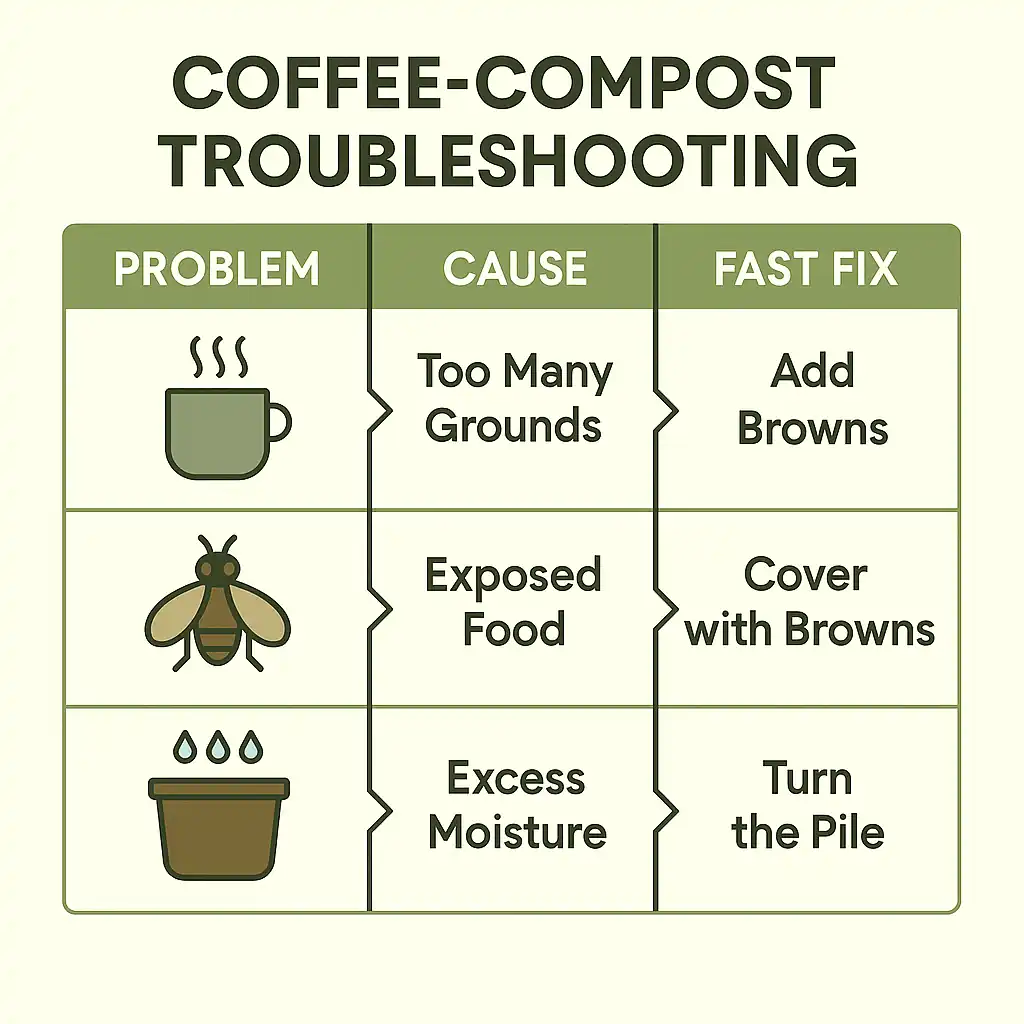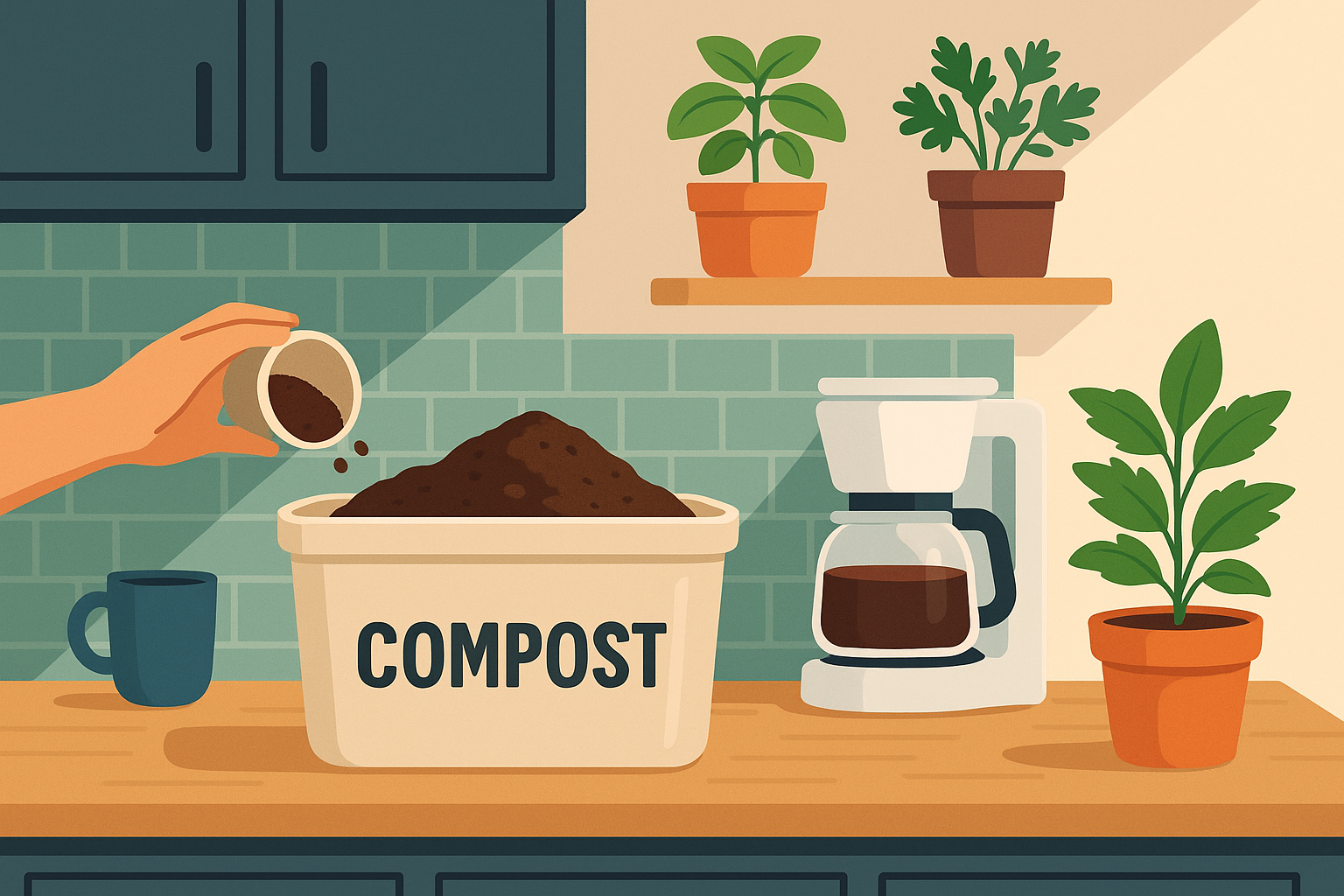How to Compost Coffee Grounds in Small Apartment
Updated Jun 2025 · 8-min read
How to compost coffee grounds in small apartment kitchens is simpler than most renters think. With a shoebox-size bin, shredded paper, and yesterday’s espresso, you can create nutrient-rich “black gold” for herbs and houseplants—odour-free and pest-free.
Table of Contents
1 Why Compost Coffee Grounds?
| Benefit | What It Means in a Flat |
|---|---|
| Nitrogen-rich | Speeds up decomposition—grounds are ~2 % N by weight. |
| Microbe magnet | Grounds attract fungi & bacteria that jump-start composting. |
| Readily available | Two coffees a day = 3 kg feedstock per month. |
| Low odour | Spent grounds neutralise smells, ideal for shared flats. |
| Worm favourite | Red wigglers process coffee faster than most food scraps. |
Sustainability note: diverting 1 kg of coffee waste from landfill avoids ~1 kg CO₂-eq emissions (WRAP UK, 2024).
2 Best Indoor Compost Bins for Flats
| Bin Type | Footprint | Pros | Cons | Best For |
|---|---|---|---|---|
| Bokashi bucket | 25 × 25 cm | Airtight, zero smell, handles meat | Must buy bokashi bran | Under-sink users |
| Stacking worm tower | 35 × 35 cm | Fast, nutrient-dense castings | Needs 18–22 °C, moisture | Warm kitchens |
| Countertop caddy | 18 × 18 cm | Cheap, starter-friendly | Empty weekly | Tiny studios |
| Electric “food recycler” | 28 × 28 cm | 24-h finish, odour filter | Uses electricity, pricey | Tech enthusiasts |
Tip: Measure the space under your sink or on your balcony shelf before ordering, mis-sizing is the #1 complaint in Amazon UK reviews.
3 Step-by-Step Guide
3.1 Gather Materials
- Airtight bin from the table above
- Browns: shredded paper, dried leaves, cardboard, coconut coir
- Greens: used coffee grounds, veg peelings, spent tea, herb stalks
- Inoculant: 2 tbsp bokashi bran or a handful of finished compost
3.2 The “3 : 1 Recipe”
Ratio: three parts browns to one part greens.
This balance of carbon (browns) and nitrogen (greens) keeps microbes thriving without turning the pile slimy or smelly.
3.3 Five-Step Process
- Layer browns – 3 cm shredded cardboard for drainage.
- Add greens – up to two cups fresh coffee grounds plus chopped veg scraps.
- Inoculate – sprinkle bokashi bran or old compost to seed microbes.
- Compress & close – press gently to remove air gaps, then seal.
- Mix weekly – aerate with a hand trowel; contents should feel like a damp sponge.
3.4 Timeline
| Week | What Happens | Your Job |
|---|---|---|
| 1–2 | Microbes ramp up; heat rises | Stir once, add browns if wet |
| 3–4 | Volume drops noticeably | Maintain 3 : 1 ratio |
| 5–6 | Earthy smell, crumbly texture | Stop feeding; let it “cure” |
| 7–8 | Mature compost ready | Sift & use on plants |

4 Balancing Browns & Greens
| Material Type | Examples | Compost Role |
|---|---|---|
| Browns (carbon) | Shredded paper, dried leaves, sawdust | Provide energy, prevent sogginess |
| Greens (nitrogen) | Coffee grounds, veg scraps, tea bags | Build proteins, speed decay |
Rule of thumb: if the pile smells sour or looks slimy, add more browns; if it’s bone-dry and slow, add a dash of greens.
5 Troubleshooting & Pro Tips
| Problem | Likely Cause | Quick Fix |
|---|---|---|
| Vinegar smell | Too many grounds (acidic) | Add crushed eggshells + extra browns |
| Fruit flies | Food exposed | Cover scraps, keep lid tight |
| Mouldy white fuzz | Normal actinomycetes | Leave—it’s healthy decomposition |
| Soggy bin | Excess moisture | Stir + add shredded cardboard |
| Bin too dry | Low moisture (<40 %) | Mist water till damp-sponge feel |

6 Using the Finished Compost
6.1 Which Plants Benefit Most?
- Acid-lovers: blueberries, azalea, camellia, roses
- Leafy greens: basil, parsley, spinach, lettuce
- Houseplants: monstera, pothos, philodendron
- Balcony veg: cherry tomatoes, dwarf chillies
6.2 Application Rates
| Method | How Much | Frequency |
|---|---|---|
| Top-dressing | 1 cm layer on pot surface | Every 3 months |
| Soil blend | 1 part compost : 4 parts potting mix | At repot |
| DIY mulch | 0.5 cm ring (keep 2 cm from stems) | Monthly in summer |
6.3 Bonus Uses
- Compost tea: steep 2 cups compost in 10 L water for 24 h; water foliage.
- Seed-starting mix: 10 % compost improves germination (RHS trial, 2023).
7 Sustainability Snapshot
| Impact Area | Apartment Compost Benefit |
|---|---|
| Landfill space | Coffee grounds diverted from rubbish |
| Greenhouse gas | 1 kg grounds saved = 1 kg CO₂-eq avoided |
| Chemical fertiliser | Replaced by homemade organic nutrients |
| Circular economy | Waste → resource loop closed at home. Learn more |
8 FAQ
Will coffee grounds make the compost too acidic?
Not if you keep the 3 : 1 browns-to-greens balance and aerate weekly.
How long before I can use the compost?
Usually 6–8 weeks indoors; bokashi pre-fermentation can cut it to 4–5 weeks.
Do worms mind caffeine?
Brewed grounds retain <2 % of original caffeine—harmless at household volumes.
Can I compost paper coffee cups?
Only if they’re certified home-compostable (look for EN 13432). Standard cups have plastic linings—skip them.
9 Quick Checklist
- Choose a bin that fits your footprint.
- Stick to the 3 : 1 browns-to-greens ratio.
- Mix or drain weekly to control moisture and odour.
- Let compost cure 2 weeks before feeding plants.
- Snap your own “how to compost coffee grounds in small apartment” setup and share with #CoffeeGroundCompost.
Kaleem,
greenlifehub.com.

